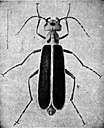meloid
Also found in: Thesaurus.
mel·oid
(mĕl′oid′, mĕl′ō-ĭd)n.
See blister beetle.
[From New Latin Meloidae, family name, from Meloē, type genus.]
mel′oid′ adj.
American Heritage® Dictionary of the English Language, Fifth Edition. Copyright © 2016 by Houghton Mifflin Harcourt Publishing Company. Published by Houghton Mifflin Harcourt Publishing Company. All rights reserved.
meloid
(ˈmɛlɔɪd)n
(Animals) any long-legged beetle of the family Meloidae, which includes the blister beetles and oil beetles
adj
(Animals) of, relating to, or belonging to the Meloidae
[C19: from New Latin Meloē name of genus]
Collins English Dictionary – Complete and Unabridged, 12th Edition 2014 © HarperCollins Publishers 1991, 1994, 1998, 2000, 2003, 2006, 2007, 2009, 2011, 2014
ThesaurusAntonymsRelated WordsSynonymsLegend:
Switch to new thesaurus
| Noun | 1. |  meloid - beetle that produces a secretion that blisters the skin meloid - beetle that produces a secretion that blisters the skinbeetle - insect having biting mouthparts and front wings modified to form horny covers overlying the membranous rear wings family Meloidae, Meloidae - blister beetles oil beetle - any of various beetles that exude an oily substance from the leg joints that deters enemies Spanish fly - green beetle of southern Europe |
Based on WordNet 3.0, Farlex clipart collection. © 2003-2012 Princeton University, Farlex Inc.